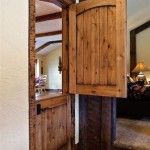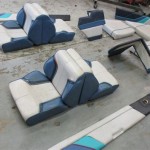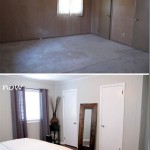How To Cover Interior Concrete Walls
Interior concrete walls, while offering a modern and industrial aesthetic, can present challenges in terms of décor and functionality. Their inherent coldness, potential porosity, and stark appearance often necessitate covering them to enhance the comfort and visual appeal of a living space. This article outlines various techniques and materials available for covering interior concrete walls, providing a comprehensive guide for homeowners and contractors seeking to transform these surfaces.
Assessing the Concrete Wall
Before commencing any covering project, a thorough assessment of the concrete wall is crucial. This involves identifying any existing issues that need to be addressed to ensure a successful and lasting outcome. Key factors to consider include:
Moisture Content: Concrete is porous and can absorb moisture from the surrounding environment. High moisture levels can lead to the failure of adhesives, paint, or other covering materials. A moisture meter should be used to determine the moisture content of the concrete. If the reading exceeds acceptable levels (typically specified by the manufacturer of the covering material), remediation steps must be taken. These steps may involve improving ventilation, applying a moisture barrier, or addressing underlying water leaks.
Surface Imperfections: Concrete walls often exhibit imperfections such as cracks, holes, and uneven surfaces. These imperfections must be repaired before applying any covering material. Small cracks can be filled with concrete patching compound, while larger cracks may require more extensive repairs, such as epoxy injection. Holes can be filled with mortar or concrete filler. Uneven surfaces can be leveled using a self-leveling compound or by grinding down high spots.
Surface Cleanliness: The concrete surface must be clean and free of dust, dirt, grease, and other contaminants. These contaminants can interfere with adhesion and compromise the integrity of the covering. The surface can be cleaned using a pressure washer, scrub brush, and a suitable cleaning solution. Oil stains may require a degreaser or specialized cleaning product. After cleaning, the surface should be thoroughly rinsed and allowed to dry completely.
Existing Coatings: If the concrete wall has been previously painted or coated, the existing coating must be assessed for adhesion and compatibility with the new covering material. Loose or peeling coatings should be removed by scraping, sanding, or using a chemical stripper. Glossy coatings may need to be roughened by sanding to promote better adhesion. If the existing coating is in good condition and compatible with the new covering, it may be possible to prime over it.
Covering Options: Paint and Textures
Paint is a commonly used and cost-effective method for covering interior concrete walls. It offers a wide range of colors and finishes, allowing for customization to suit different aesthetic preferences. However, proper preparation and the selection of appropriate paint products are essential for achieving optimal results.
Primer Selection: A primer is a crucial component of any painting project, especially on concrete surfaces. It provides a uniform base for the paint, improves adhesion, and helps to seal the porous concrete. An alkali-resistant primer is recommended for concrete walls, as concrete can leach alkaline compounds that can damage certain paints. The primer should be applied in accordance with the manufacturer's instructions, typically in one or two coats.
Paint Selection: The choice of paint depends on the desired finish, durability, and moisture resistance. Acrylic latex paints are generally recommended for interior concrete walls due to their flexibility, breathability, and resistance to cracking. For areas exposed to high moisture levels, such as bathrooms or basements, a mildew-resistant paint is advisable. Epoxy paints offer excellent durability and water resistance, but they may require special application techniques and are typically used in commercial or industrial settings.
Texturing Techniques: Adding texture to the concrete wall can enhance its visual appeal and conceal imperfections. Several texturing techniques can be employed, including:
- Stipple: This technique involves using a stippling brush or sponge to create a textured surface.
- Orange Peel: This texture is achieved by spraying a textured coating onto the wall, creating a slightly bumpy appearance.
- Knockdown: This texture is created by applying a textured coating and then using a trowel to flatten the peaks, resulting in a subtle, textured surface.
Texturing adds visual interest and complexity to a plain concrete wall, however, proper surface preparation and consistent technique are essential for optimal appearance.
Covering Options: Paneling and Drywall
Paneling and drywall offer alternative methods for covering interior concrete walls, providing a wider range of design options and improved insulation. These methods involve attaching panels or drywall sheets to the concrete wall using furring strips or adhesive.
Furring Strips Installation: Furring strips are thin strips of wood or metal that are attached to the concrete wall to create a framework for the paneling or drywall. These strips provide an air gap between the concrete wall and the covering material, which can help to improve insulation and prevent moisture buildup. The furring strips should be installed vertically, horizontally, or in a grid pattern, depending on the desired orientation of the paneling or drywall. They can be attached to the concrete wall using concrete nails, screws, or adhesive. Leveling the furring strips is critical for achieving a flat and even surface.
Paneling Installation: Paneling is available in a variety of materials, including wood, laminate, and PVC. It can be installed directly onto the furring strips using nails, screws, or adhesive. The panels should be cut to size and fitted together tightly to create a seamless appearance. Consider the expansion and contraction properties of the paneling material and leave appropriate gaps where needed.
Drywall Installation: Drywall is a versatile material that can be used to create a smooth and paintable surface on concrete walls. It is installed onto the furring strips using drywall screws. The drywall sheets should be staggered to avoid creating continuous seams. After installation, the seams are taped and mudded to create a smooth transition. The drywall can then be primed and painted to achieve the desired finish.
Advantages and Disadvantages: Paneling offers a quick and easy way to cover concrete walls, providing a finished appearance without the need for painting. However, it may not be as versatile as drywall in terms of design options. Drywall, on the other hand, allows for a wide range of finishes and textures, but it requires more time and effort to install and finish. Ultimately, the choice between paneling and drywall depends on the specific needs and preferences of the homeowner.
Covering Options: Fabric and Wallpaper
Fabric and wallpaper offer alternative decorative solutions for covering interior concrete walls, providing unique textures, patterns, and visual interest. These options require careful consideration of adhesive compatibility and wall preparation.
Fabric Installation: Fabric can be attached to concrete walls using various methods, including adhesive, staples, or a combination of both. The fabric should be pre-treated to prevent shrinking or stretching. A backing material, such as batting or foam, can be used to provide cushioning and insulation. The fabric can be draped, stretched, or pleated to create different effects. The edges of the fabric should be neatly finished to prevent fraying.
Wallpaper Installation: Wallpaper offers a wide range of patterns, colors, and textures, allowing for customization to suit different design styles. The concrete wall must be properly prepared by priming and smoothing any imperfections. A paste specifically designed for wallpaper should be used to ensure proper adhesion. The wallpaper should be carefully aligned and smoothed to avoid air bubbles and wrinkles. The seams should be tightly butted together to create a seamless appearance. Pre-pasted wallpaper simplifies installation. However, careful saturation and adherence to the manufacturer's instructions avoids failures.
Considerations: Both fabric and wallpaper can add warmth and texture to a concrete wall, but they may not be as durable as other covering options. They are also more susceptible to moisture damage and staining. Regular cleaning and maintenance are essential to preserve their appearance. Consider the intended use of the room and the potential for wear and tear when choosing between fabric and wallpaper.
In conclusion, selecting the appropriate covering method for interior concrete walls requires a thorough assessment of the wall's condition, consideration of the desired aesthetic, and understanding of the installation process. Each method offers unique advantages and disadvantages, and the best choice depends on the specific needs and preferences of the homeowner.

Stylish Solutions Covering Unfinished Basement Walls Csg Renovation

Stylish Solutions Covering Unfinished Basement Walls Csg Renovation

10 Ways To Cover Concrete Walls In A Basement Finish

Stylish Solutions Covering Unfinished Basement Walls Csg Renovation

Decorating Ideas For Interior Concrete Walls

How To Insulate A Basement Wall Greenbuildingadvisor

Exposed Concrete Wall Ideas Embracing The Raw Beauty Fabdiz

36 Modern And Chic Concrete Home Décor Ideas Digsdigs

Make A Statement With Concrete Walls Direct Paint

The Sheer Beauty Of Concrete Walls
Related Posts








